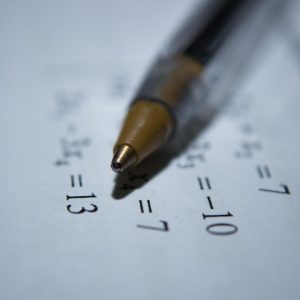The unit circle is a fundamental concept in trigonometry that is used to understand the relationships between the angles and the trigonometric functions. It is a circle with a radius of 1, centered at the origin of a coordinate plane. The unit circle is divided into four quadrants, each representing different signs of the trigonometric functions. The x-axis and y-axis intersect at the center of the unit circle, creating a right angle. This allows for easy visualization of the values of sine, cosine, and tangent for any angle on the unit circle. The unit circle is a powerful tool for solving trigonometric equations and understanding the behavior of trigonometric functions.
The unit circle is also used to define the six trigonometric functions: sine, cosine, tangent, cosecant, secant, and cotangent. These functions are defined as ratios of the sides of a right triangle in relation to its angles. The unit circle provides a way to extend these definitions to any angle, not just those in a right triangle. By using the unit circle, we can easily find the values of these trigonometric functions for any angle, making it an essential tool in trigonometry and calculus.
Key Takeaways
- The unit circle is a circle with a radius of 1, centered at the origin of a coordinate plane.
- To use the unit circle table, identify the angle in radians or degrees and find the corresponding trigonometric values for sine, cosine, and tangent.
- Common trigonometric values on the unit circle table include (1, 0), (0, 1), (-1, 0), and (0, -1) for the points where the circle intersects the x and y axes.
- The unit circle and trigonometric functions are closely related, with the x and y coordinates of the unit circle representing the cosine and sine values of an angle, respectively.
- To memorize the unit circle table, use mnemonic devices, practice regularly, and understand the patterns and symmetries of the trigonometric values.
How to Use the Unit Circle Table
To use the unit circle table, start by understanding the coordinates of the points on the unit circle. Since the radius of the unit circle is 1, the coordinates of any point on the unit circle can be represented as (cos θ, sin θ), where θ is the angle formed by the terminal side of the angle and the positive x-axis. The x-coordinate represents the cosine of the angle, and the y-coordinate represents the sine of the angle. By using this relationship, we can easily find the values of sine and cosine for any angle on the unit circle.
The unit circle table provides a quick reference for the values of sine and cosine for common angles. For example, at 0 degrees (or 0 radians), the coordinates of the point on the unit circle are (1, 0), representing the cosine and sine values for 0 degrees. Similarly, at 90 degrees (or π/2 radians), the coordinates are (0, 1), representing the cosine and sine values for 90 degrees. By using this table, we can quickly find the values of sine and cosine for any angle without having to calculate them each time.
Common Trigonometric Values on the Unit Circle Table
The unit circle table provides a reference for common trigonometric values for angles in both degrees and radians. For example, at 0 degrees (or 0 radians), the cosine value is 1 and the sine value is 0. At 30 degrees (or π/6 radians), the cosine value is √3/2 and the sine value is 1/2. At 45 degrees (or π/4 radians), both the cosine and sine values are 1/√2. At 60 degrees (or π/3 radians), the cosine value is 1/2 and the sine value is √3/2. At 90 degrees (or π/2 radians), the cosine value is 0 and the sine value is 1.
These common values are essential for solving trigonometric equations and understanding the behavior of trigonometric functions. By memorizing these values or using a unit circle table as a reference, we can quickly find the values of sine and cosine for these common angles without having to calculate them each time.
Understanding the Relationship between the Unit Circle and Trigonometric Functions
| Angle (θ) | Sine (sin θ) | Cosine (cos θ) | Tangent (tan θ) |
|---|---|---|---|
| 0° | 0 | 1 | 0 |
| 30° | 1/2 | √3/2 | √3/3 |
| 45° | √2/2 | √2/2 | 1 |
| 60° | √3/2 | 1/2 | √3 |
| 90° | 1 | 0 | undefined |
The unit circle provides a visual representation of the relationship between angles and trigonometric functions. By understanding this relationship, we can easily find the values of sine, cosine, and tangent for any angle on the unit circle. For example, when an angle θ is formed with the positive x-axis, the coordinates of the point on the unit circle are (cos θ, sin θ), representing the cosine and sine values for that angle. The tangent of that angle can be found by taking the ratio of sin θ to cos θ.
Furthermore, by dividing the unit circle into four quadrants, we can determine the signs of sine, cosine, and tangent for any angle. In quadrant I, all trigonometric functions are positive. In quadrant II, only sine is positive. In quadrant III, only tangent is positive. In quadrant IV, only cosine is positive. This understanding allows us to determine the signs of trigonometric functions for any angle on the unit circle.
Tips for Memorizing the Unit Circle Table
Memorizing the unit circle table can be challenging, but there are several tips that can make it easier. One approach is to break down the table into smaller sections and memorize them one at a time. For example, start by memorizing the values for 0 degrees, 30 degrees, 45 degrees, 60 degrees, and 90 degrees (or their equivalent in radians). Once these values are memorized, move on to memorizing values for angles in other quadrants.
Another tip is to use patterns to help remember the values on the unit circle. For example, notice that in quadrant I, both sine and cosine are positive; in quadrant II, only sine is positive; in quadrant III, only tangent is positive; and in quadrant IV, only cosine is positive. By recognizing these patterns, it becomes easier to remember the values for each angle.
Additionally, creating mnemonic devices or visual aids can be helpful for memorizing the unit circle table. For example, creating a mnemonic phrase using the first letter of each trigonometric function (such as “All Students Take Calculus”) can help remember which functions are positive in each quadrant.
Applications of the Unit Circle Table in Trigonometry

The unit circle table has numerous applications in trigonometry and calculus. It is used to solve trigonometric equations, graph trigonometric functions, and understand their behavior. By using the values on the unit circle table, we can quickly find the sine and cosine values for any angle without having to calculate them each time.
The unit circle table is also used to define inverse trigonometric functions such as arcsine, arccosine, and arctangent. These functions allow us to find angles given their trigonometric values. For example, if we know that sin θ = 1/2, we can use the unit circle table to find that θ = π/6 or 30 degrees.
Furthermore, in calculus, the unit circle table is used to define trigonometric functions as power series through Taylor series expansions. This allows us to extend our understanding of trigonometric functions beyond just their values on the unit circle.
Practice Problems Using the Unit Circle Table
To reinforce understanding of the unit circle table, it’s important to practice solving problems using it. For example, given an angle θ, we can use the unit circle table to find its sine and cosine values. We can also use it to determine which quadrant θ lies in and find its tangent value accordingly.
Another practice problem could involve finding angles given their trigonometric values using inverse trigonometric functions. For example, given sin θ = √3/2, we can use the unit circle table to find that θ = π/3 or 60 degrees.
Additionally, practicing graphing trigonometric functions using values from the unit circle table can help reinforce understanding of their behavior. By plotting points from the unit circle table and connecting them with smooth curves, we can visualize how these functions behave as angles change.
In conclusion, understanding and memorizing the unit circle table is essential for success in trigonometry and calculus. By using this powerful tool, we can easily find trigonometric values for any angle and solve a wide range of problems in mathematics. With practice and dedication, mastering the unit circle table can open up a world of possibilities in higher mathematics.
If you’re looking for a related article to the unit circle table, you might want to check out this article on the benefits of using a unit circle in trigonometry. The article discusses how the unit circle can help students visualize and understand trigonometric functions, and provides examples of how it can be used in problem-solving. You can read the full article here.
FAQs
What is a unit circle table?
A unit circle table is a table that lists the values of trigonometric functions (sine, cosine, tangent, etc.) for angles measured in radians on the unit circle.
What is the unit circle?
The unit circle is a circle with a radius of 1, centered at the origin of a coordinate plane. It is used in mathematics to define trigonometric functions and their values for various angles.
What information does a unit circle table provide?
A unit circle table provides the values of trigonometric functions (sine, cosine, tangent, etc.) for specific angles measured in radians on the unit circle.
How is a unit circle table used?
A unit circle table is used to quickly reference the values of trigonometric functions for specific angles, making it easier to solve trigonometric equations and problems.
What are the common angles included in a unit circle table?
Common angles included in a unit circle table are 0, π/6, π/4, π/3, π/2, π, 3π/2, 2π, and their multiples, as these angles have simple and easily memorizable trigonometric function values.
Why is the unit circle table important?
The unit circle table is important because it provides a convenient reference for the values of trigonometric functions, making it easier for students and professionals to work with trigonometry in various mathematical and scientific applications.





